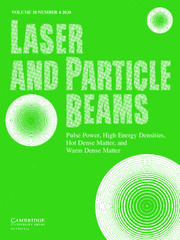Article contents
Rayleigh–Taylor turbulent mixing evolution under a shock influence
Published online by Cambridge University Press: 07 March 2001
Abstract
At the installation SOM, the experimental study of the impulse acceleration influence on the behavior of the turbulized layer obtained as a result of Rayleigh–Taylor instability (RTI) action on the system of two different density liquids with the density ratio n = 3, has been performed. After application of impulse acceleration the systems were moving according to inertia, and by using the light method the coordinates of penetration of the heavier liquid into the lighter one and vice versa were determined. The liquids studied were placed inside the ampoule that had internal working sizes (54 × 64 × 120) mm3. There were initial accidental perturbations like a rough solid surface at the interface and the width of the initial perturbation zone was L0 = 2.3 mm. The moving ampoule blow against metal plates created the impulse acceleration. The relative impulse acceleration was δg/g11 = 22.2–66.6 where g11 is the ampoule acceleration before the impact, the impulse duration was varied from 0.27 ms to 0.096 ms. The results concerned with the turbulized layer extension after the impulse acceleration action were obtained.
Information
- Type
- ZABABAKHIN SPECIAL PAPERS
- Information
- Copyright
- © 2000 Cambridge University Press
- 1
- Cited by

